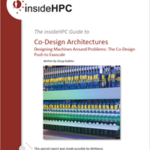The big data analytics market has seen rapid growth in recent years. Part of this trend includes the increased use of machine learning (Deep Learning) technologies. Indeed, machine learning speed has been drastically increased though the use of GPU accelerators. The issues facing the HPC market are similar to the analytics market — efficient use of the underlying hardware. A position paper from the third annual Big Data and Extreme Computing conference (2015) illustrates the power of co-design in the analytics market.
Network Co-design as a Gateway to Exascale
Achieving better scalability and performance at Exascale will require full data reach. Without this capability, onload architectures force all data to move to the CPU before allowing any analysis. The ability to analyze data everywhere means that every active component in the cluster will contribute to the computing capabilities and boost performance. In effect, the interconnect will become its own “CPU” and provide in-network computing capabilities.
Co-Design Offloading
The move to network offloading is the first step in co-designed systems. A large amount of overhead is required to service the huge number of packets required for modern data rates. This amount of overhead can significantly reduce network performance. Offloading network processing to the network interface card helped solve this bottleneck as well as some others.
The insideHPC Guide to Co Design Architecture
The use of Co-Design and offloading are important tools in achieving Exascale computing. Application developers and system designers can take advantage of network offload and emerging co-design protocols to accelerate their current applications. Adopting some basic co-design and offloading methods to smaller scale systems can achieve more performance on less hardware resulting in low cost and higher throughput. Learn more by downloading this guide.
The Evolution of HPC
“When the history of HPC is viewed in terms of technological approaches, three epochs emerge. The most recent epoch, that of co-design systems, is new and somewhat unfamiliar to many HPC practitioners. Each epoch is defined by a fundamental shift in design, new technologies, and the economics of the day. “A network co-design model allows data algorithms to be executed more efficiently using smart interface cards and switches. As co-design approaches become more mainstream, design resources will begin to focus on specific issues and move away from optimizing general performance.”
Designing Machines Around Problems: The Co-Design Push to Exascale
A single issue has always defined the history of HPC systems: performance. While offloading and co-design may seem like new approaches to computing, they actually have been used, to a lesser degree, in the past as a way to enhance performance. Current co-design methods are now going deeper into cluster components than was previously possible. These new capabilities extend from the local cluster nodes into the “computing network.”
Co-Design Architecture: Emergence of New Co-Processors
“High performance computing has begun scaling beyond Petaflop performance towards the Exaflop mark. One of the major concerns throughout the development toward such performance capability is scalability – at the component level, system level, middleware and the application level. A Co-Design approach between the development of the software libraries and the underlying hardware can help to overcome those scalability issues and to enable a more efficient design approach towards the Exascale goal.”
InfiniBand Enables Intelligent Networks
“The path to Exascale computing is clearly paved with Co-Design architecture. By using a Co-Design approach, the network infrastructure becomes more intelligent, which reduces the overhead on the CPU and streamlines the process of passing data throughout the network. A smart network is the only way that HPC data centers can deal with the massive demands to scale, to deliver constant performance improvements, and to handle exponential data growth.”








